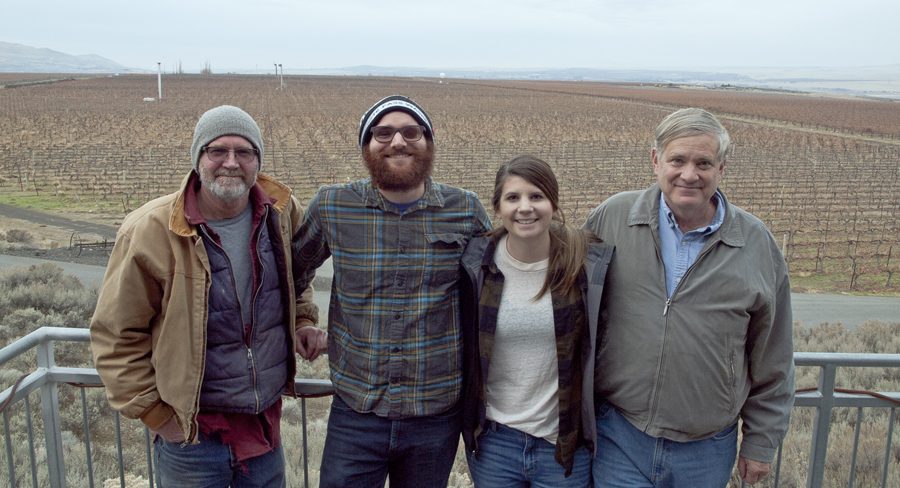
Home » Red Mountain pioneers collaborate on Cabernet for a cause
Red Mountain pioneers collaborate on Cabernet for a cause

December 13, 2018
Two Red Mountain wineries are collaborating on a special vintage this year in honor of their 40th anniversary.
In 1978, Barnard Griffin’s founder Rob Griffin produced the first Red Mountain commercial wine using grapes grown by John Williams and Jim Holmes at their Kiona Estate vineyard outside Benton City.
Forty years later, their kids and grandkids are grown and involved in the family wine business.
To honor their long, rich history as pioneers in a now burgeoning wine region, JJ Williams, manager at Kiona Vineyards and Winery, the grandson of John Williams, reached out to Megan Hughes, daughter of Rob Griffin, with a proposal to commemorate 40 years of Red Mountain winemaking.
He suggested providing a small amount of Cabernet Sauvignon fruit from the original 1975 planting and having Barnard Griffin turn it into wine. The bottles then would be jointly sold, with the proceeds benefiting a local charity.
Hughes was delighted with the idea, and on Oct. 20, the 2018 Cabernet crop was picked from Kiona’s “Old Block,” the original 10 acres on which John Williams and Jim Holmes began their endeavor to prove to the world that winemaking on Red Mountain was possible.
“I think it’s important to acknowledge what’s happened in the past and work toward the next 40, 50 years,” JJ Williams said.
“Nobody has more growing experience on Red Mountain than the Williams family, and nobody has more experience with Red Mountain fruit on the vinification side than Rob. So, if anyone can make the perfect Red Mountain wine, this is it,” Hughes said.
Though it will be two to three years before anyone tastes the limited-edition vintage, Hughes and Williams said Second Harvest in Pasco will receive all proceeds from the anniversary Cabernet’s sales.
“We are honored to be the chosen beneficiary of this special anniversary collaboration. It’s heartwarming to know that the long-awaited wine will also put food on the tables of our neighbors in need,” said Jean Tucker, development and marketing director at the Pasco food bank.
Pricing, exact quantities and what the labeling will look like have yet to be determined.
Due to the limited production, anticipated popularity and the charitable component, the two wineries encourage those interested in buying it to sign up for email updates on production and future release date on their websites.
“I’m sure it will be sold out before it’s ever bottled,” Hughes said.
“Ultimately, the support of the community is what’s going to make it work. It’s the customers collectively who are going to make this work,” Griffin said.
That’s been a key theme for Kiona and Barnard Griffin’s longtime operations.
JJ Williams said not many early winemakers, or those in business even a couple of decades ago, are around today.
“The thing that maybe gets missed … is that the vast majority of those wineries are no longer in business. So, to have two entities be around for as long as we have, with the structures that we have, while being independently owned and operated without corporate backing, without high-powered marketing or research firms pushing that and surviving multi-generations — I can count on one hand, really, the number of wineries that fit into that,” he said.
“It took vision and audacity when they decided to try to rip up the desert and put grapes there,” Griffin said of John Williams and Jim Holmes.
Water was the critical component needed to make wine grape growing on Red Mountain possible, said JJ Williams. As Kiona’s story goes, John Williams and Jim Holmes commissioned a well, but by 550 feet deep, they had yet to strike water.
Unsure if they should continue, the pair considered costs and determined they could afford to dig another 10 feet.
The next morning, water began to pool at the bottom.
“In those days, you had to sell the idea first,” Griffin recalled of the early wine industry. Basic supplies were hard to come by and there weren’t local experienced industry leaders to learn from.
Despite the market being more crowded in the present day, JJ Williams feels that there’s still, “lots of mutual respect in the industry. I think Washington has a pretty unique community in that everyone else is interested in everyone else’s well-being.”
Part of this is attributed to the team effort required to create a regional wine scene. Though Washington is the second largest producer of wine in the country, JJ Williams said it only accounts for 5 percent of national production.
In the case of Red Mountain wines, camaraderie among producers is key, especially if one is a grape grower and winemaker, like Kiona.
“It changes the strategy for marketing because it’s in our best interest for all Washington wine, and particularly Red Mountain wine, to be well received. We are a supplier to our competitors,” JJ Williams said.
“We’re farming fruit for more than 60 wineries. If someone makes a Red Mountain wine, there’s a good chance we’re the grower,” he added.
Today, Kiona has 260-plus acres under cultivation on Red Mountain. The viticultural area’s planted acreage has doubled in the past 10 years.
Another reason for Barnard Griffin and Kiona’s success has been the eagerness of the families’ next generation to continue the business.
“It was never expected that my brother and I would be in the industry, but the opportunity was certainly made clear. I can only imagine it was a sigh of relief,” JJ Williams said.
“It’s what you hope for in a family business,” Griffin said.
For more information on the collaboration and to sign up for updates on the commemorative wine, visit Kiona Vineyards and Winery at kionawine.com and Barnard Griffin at barnardgriffin.com.
Local News Entrepreneur Startup Ecosystems
KEYWORDS december 2018





